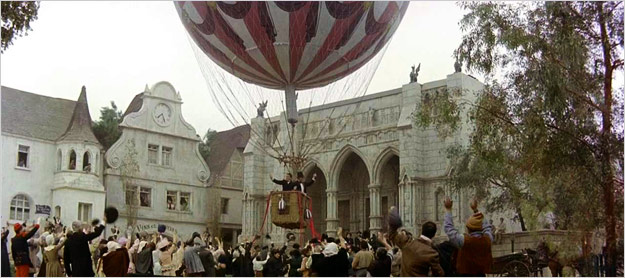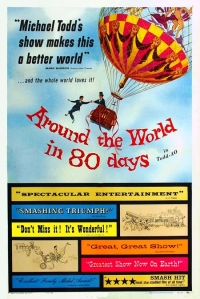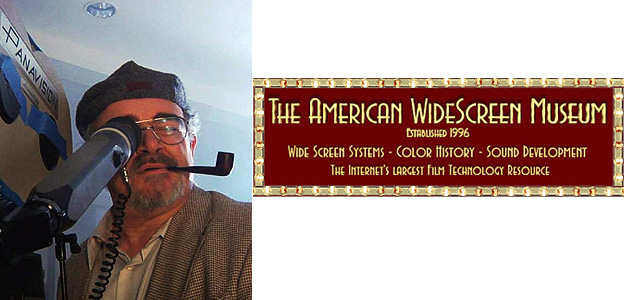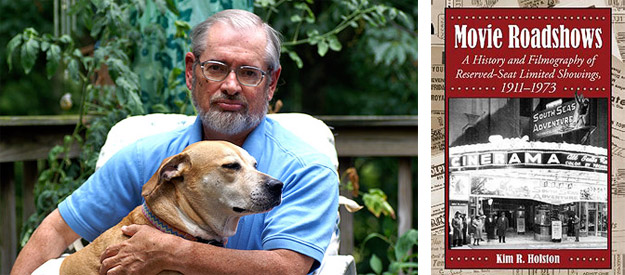THE Q&A
Sheldon Hall is the author (with Steve Neale) of Epics, Spectacles, and Blockbusters: A Hollywood History (Wayne State University Press, 2010). He is a Senior Lecturer in film studies at Sheffield Hallam University, UK. Other books of his include Zulu: With Some Guts Behind It—The Making of the Epic Movie (Tomahawk Press, 2005; updated in 2014) and (with John Belton and Steve Neale) Widescreen Worldwide (Indiana University Press, 2010).
Martin Hart is the curator of the American Widescreen Museum.
Kim Holston is the author of Movie Roadshows: A History and Filmography of Reserved-Seat Limited Showings, 1911-1973 (McFarland, 2013). Kim is a part-time librarian in the Multimedia Department of Chester County Library (Exton, PA) and lives in Wilmington, DE, with his wife Nancy and a menagerie of pets. He is the author of various film and performing arts books, including Starlet (McFarland, 1988), Richard Widmark: A Bio-Bibliography (Greenwood Press, 1990), Susan Hayward: Her Films and Life (McFarland, 2002), and (with Warren Hope) The Shakespeare Controversy (McFarland, 2nd ed., 2009), and recently Attila’s Sorceress (New Libri Press, 2014) and Naval Gazing: How Revealed Bellybuttons of the 1960s Signaled the End of Movie Cliches Involving Negligees, Men’s Hats and Freshwater Swim Scenes (BearManor Media, 2014). He is presently at work with Tom Winchester on a follow-up to their 1997 book, Science Fiction, Fantasy and Horror Film Sequels, Series and Remakes.
The interviews were conducted separately and have been edited into a “roundtable” conversation format.
---
Michael Coate (The Digital Bits): We’ve come upon the 60th anniversary of the release of Mike Todd’s production of Around the World in Eighty Days. In what way should the film be remembered?
Sheldon Hall: It’s one of those Oscar-winners that regularly appears on lists of films that don’t deserve to have been named Best Picture; that seems largely to be how it is remembered nowadays. But it’s a better movie than its current reputation suggests, with the simple bad luck to be unfashionable and lacking in a name director (though Michael Anderson was responsible for a number of other well-liked films and is of course happily still with us). It’s a well-crafted, entertaining film that tells us a lot about the popular taste of the time, as well as being a minor milestone technically and commercially.
Martin Hart: I think Around the World in Eighty Days should be viewed just as you would any other picture, but a knowledge of cinema history helps the viewer form an opinion. For some people it can be classified as a big boring movie filled with lots of actors we don’t know playing lots of bit parts; for others it can be seen as high adventure that works its way from London to New York with the aid of dozens of top stars of the forties and early fifties…. There are very few people still alive that were able to see it in a real Todd-AO equipped theater. Most people will have seen it only on television with its poorly panned and scanned crummy NTSC color and high fidelity mono sound. That was my first exposure to it and I was terribly disappointed. My parents had seen it in 1958 in a drive-in near St. Paul, Minnesota, and had told me that it was just dreadful. That’s why I was surprised at how awful it was when I saw it on TV; my folks didn’t know quality from day old popcorn so I was expecting it to be much better…. Fortunately Warner Home Video assembled a pretty decent looking and sounding DVD from the 35mm version negative. People have complained about the transfer not having been made from the 30fps Roadshow negative and knowing the folks at Warner Home Video I think we can take their word for it that the time and cost required to make it beautiful was way out of line with any possible return. For me, I found the complete picture to be far better than many roadshow films produced during the following decades.
Kim Holston: Along with that year’s The Ten Commandments and War and Peace, it heralded the golden age of roadshows that would ramp up dramatically by the end of the decade.
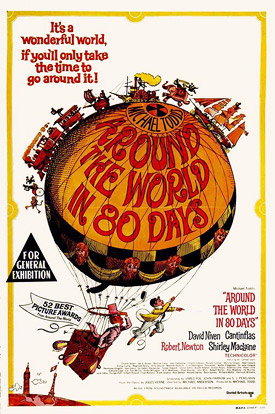 Coate: Can you describe what it was like seeing Eighty Days for the first time?
Coate: Can you describe what it was like seeing Eighty Days for the first time?
Hall: I saw it for the first time on Good Friday, 1975 — its first showing on BBC television (though it had previously been shown by the UK commercial network ITV). I was ten years old and enjoyed it enormously (note: in order to see Eighty Days I had to miss the UK TV premiere of The Robe on the rival channel). It was more than two decades later before I saw it for the first time in a cinema and I have now seen it several times in 70mm, on both a curved and a flat screen.
Hart: I first saw it on my cheesy 19” black-and-white set with typical TV sound. Not too impressed. I caught it a few years later and I had a color TV by then but there wasn’t much good that could be said about the color of that pan and scan transfer. I just knew the movie had to be better than what I’d seen thus far. Finally, many years later I had built a home theater with huge screen and about a dozen and a half speakers and that’s when I bought the DVD. In that environment and with the vastly improved picture and sound I finally felt like I had some understanding why audiences raved about the “show.” (That’s Mike Todd Speak for moom pitchers.)
Holston: I saw it during its major re-release in 1968 at the new Theatre 1812 in Philadelphia. I liked it but it didn’t knock my socks off. This might have been caused by anticipating seeing an Academy Award winner that was epic in scope and had a music score by one of the masters, Victor Young. I’d been playing the soundtrack for years.
Coate: How is Eighty Days significant among spectacles?
Hall: It was one of the first blockbuster comedies and one of the first films with a truly all-star cast: as other contributors may well point out, Mike Todd adopted the word “cameo” to describe the fleeting guest appearance of a well-known personality.
Holston: It covered the globe and was not Biblical, based on historical fact, or a flat-out travelogue.
Coate: In what way was it beneficial for Eighty Days to have been released as a roadshow?
Hall: Todd rightly understood that the film needed to be sold as a special attraction: not just a movie but a “show.” Roadshow presentation created the sense of occasion that he wanted and took the film out of the normal run of cinema. Given its high cost, large scale and three-hour length, any other form of presentation would have been counter-productive — though some other very long films released the same year were not presented as roadshows in the U.S. (Giant, War and Peace). Conversely, I don’t think Eighty Days was ever given a regular general release in the UK.
Hart: Around the World in Eighty Days, and more specifically, Mike Todd, defined the way to sell a hard ticket roadshow film. It was Todd that convinced Cinerama to go the hard ticket route and the company continued to do so for approximately 15 years. When you bought your ticket for seats 1-4 in row 15 you knew you had a reserved place to sit and you knew that dumbass that lived next door wasn’t going to be able to see it for a while. For Mike Todd it was important to present the show just like the legitimate stage on Broadway. Indeed, 70mm came to be the predominant roadshow method of presentation. There were exceptions but they were rare.
Holston: It had the scope. Theaters had to spend lots of money to upgrade their screens and sound to present it properly, but they usually did, and it paid off. Subconsciously at least, roadshows were viewed as something akin to the opera or ballet, a special event or night out.
Coate: Around the World in Eighty Days was among only a handful of films produced in Todd-AO. In what way was using that process beneficial?
Hall: It makes more extensive use of the wide-angle lens than did the first film in the process, Oklahoma!, and obviously has a much wider range of locales that could be exploited for their scenic and spatial possibilities. The “bug-eye” lens is most effectively used in the London sequences, such as in Passepartout’s cycle ride through the streets.
Hart: Strictly speaking there were only two features produced in the original Todd-AO format with its wide wall-to-wall, ceiling-to-floor curved screen [and 30 frames-per-second frame rate]. Those were Oklahoma! and Around the World in Eighty Days. [Then] it was decided to drop the frame rate to 24fps like other films. Starting with South Pacific (1958) all other Todd-AO productions were made at 24fps and most theaters used flat screens. The original Todd-AO process kicked off the large negative roadshow but the deeply curved screen did not survive other than in the unsatisfying 70mm Cinerama process.
Holston: The publicity for this new process helped entice audiences away from the small screen.
